Money Laundering: Why It Persists Despite Laws and Policies
VerifiedAdded on 2023/01/20
|19
|5048
|54
Report
AI Summary
This report provides a critical analysis of money laundering, focusing on why it persists despite numerous laws and policies enacted to combat it. It begins with an introduction defining money laundering and its sources, highlighting the challenges faced in the fight against it. The report then examines key policies and laws in the US, including the Foreign Transaction Reporting Act, the Patriot Act, and the Banking Secrecy Act, assessing their effectiveness and shortcomings. It delves into currency transaction reporting, exploring its role in detecting money laundering and the challenges of circumventing the system. The report also includes a case study of US v First National Bank. The analysis covers regional mapping of money laundering, handling of proceeds, challenges in implementation, and penalties. The report concludes by addressing the loopholes and suggesting improvements to enhance the effectiveness of anti-money laundering efforts.
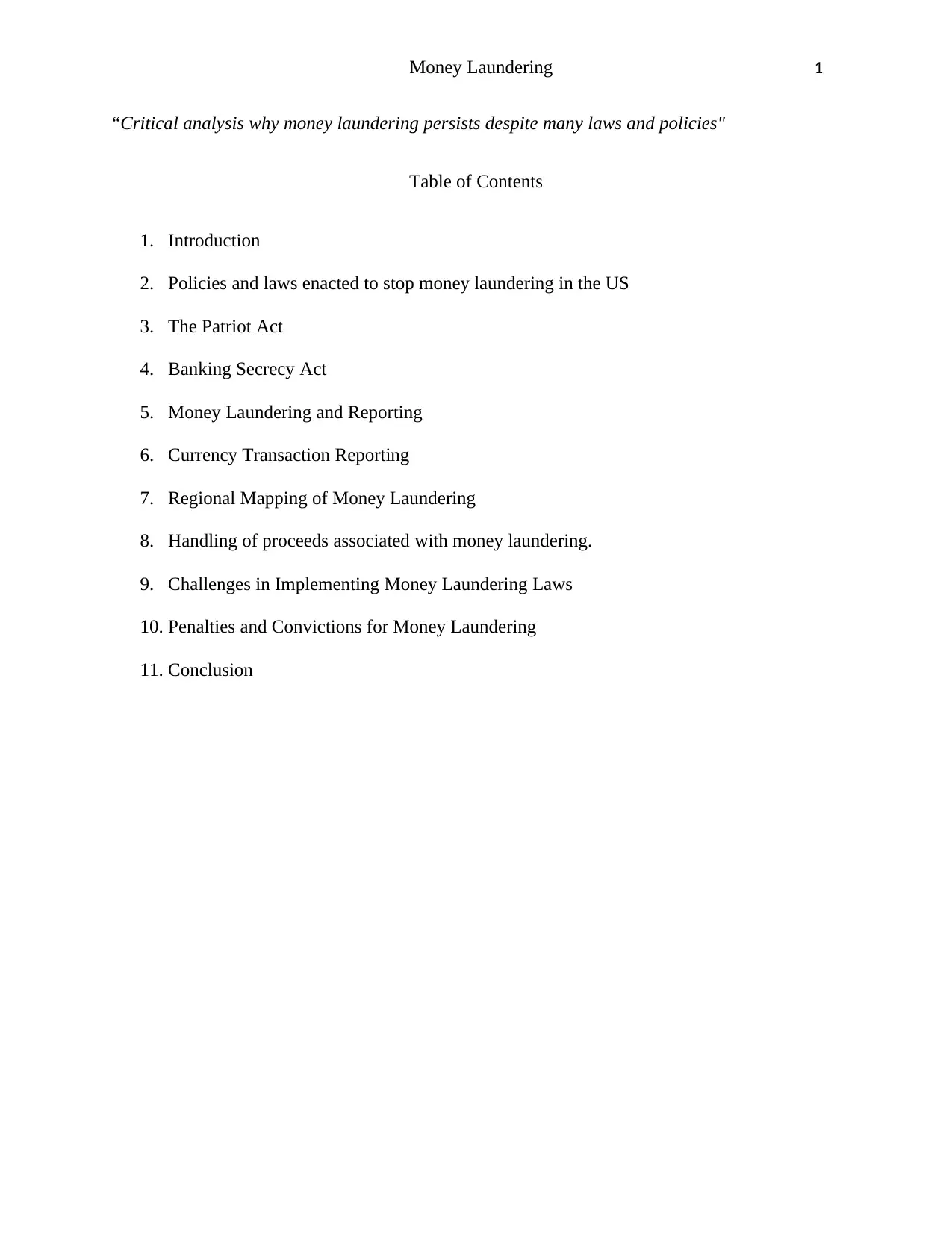
Money Laundering 1
“Critical analysis why money laundering persists despite many laws and policies"
Table of Contents
1. Introduction
2. Policies and laws enacted to stop money laundering in the US
3. The Patriot Act
4. Banking Secrecy Act
5. Money Laundering and Reporting
6. Currency Transaction Reporting
7. Regional Mapping of Money Laundering
8. Handling of proceeds associated with money laundering.
9. Challenges in Implementing Money Laundering Laws
10. Penalties and Convictions for Money Laundering
11. Conclusion
“Critical analysis why money laundering persists despite many laws and policies"
Table of Contents
1. Introduction
2. Policies and laws enacted to stop money laundering in the US
3. The Patriot Act
4. Banking Secrecy Act
5. Money Laundering and Reporting
6. Currency Transaction Reporting
7. Regional Mapping of Money Laundering
8. Handling of proceeds associated with money laundering.
9. Challenges in Implementing Money Laundering Laws
10. Penalties and Convictions for Money Laundering
11. Conclusion
Paraphrase This Document
Need a fresh take? Get an instant paraphrase of this document with our AI Paraphraser
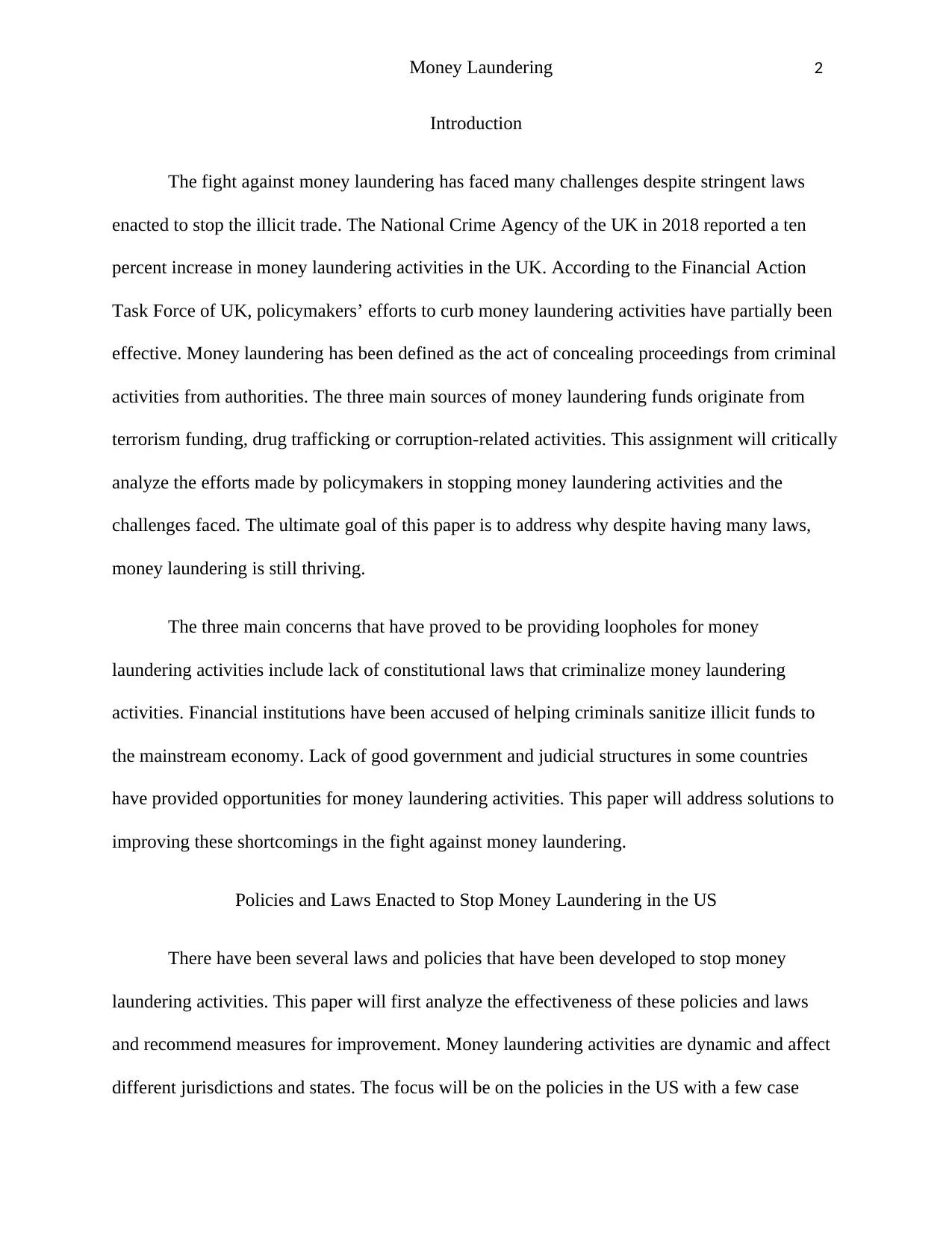
Money Laundering 2
Introduction
The fight against money laundering has faced many challenges despite stringent laws
enacted to stop the illicit trade. The National Crime Agency of the UK in 2018 reported a ten
percent increase in money laundering activities in the UK. According to the Financial Action
Task Force of UK, policymakers’ efforts to curb money laundering activities have partially been
effective. Money laundering has been defined as the act of concealing proceedings from criminal
activities from authorities. The three main sources of money laundering funds originate from
terrorism funding, drug trafficking or corruption-related activities. This assignment will critically
analyze the efforts made by policymakers in stopping money laundering activities and the
challenges faced. The ultimate goal of this paper is to address why despite having many laws,
money laundering is still thriving.
The three main concerns that have proved to be providing loopholes for money
laundering activities include lack of constitutional laws that criminalize money laundering
activities. Financial institutions have been accused of helping criminals sanitize illicit funds to
the mainstream economy. Lack of good government and judicial structures in some countries
have provided opportunities for money laundering activities. This paper will address solutions to
improving these shortcomings in the fight against money laundering.
Policies and Laws Enacted to Stop Money Laundering in the US
There have been several laws and policies that have been developed to stop money
laundering activities. This paper will first analyze the effectiveness of these policies and laws
and recommend measures for improvement. Money laundering activities are dynamic and affect
different jurisdictions and states. The focus will be on the policies in the US with a few case
Introduction
The fight against money laundering has faced many challenges despite stringent laws
enacted to stop the illicit trade. The National Crime Agency of the UK in 2018 reported a ten
percent increase in money laundering activities in the UK. According to the Financial Action
Task Force of UK, policymakers’ efforts to curb money laundering activities have partially been
effective. Money laundering has been defined as the act of concealing proceedings from criminal
activities from authorities. The three main sources of money laundering funds originate from
terrorism funding, drug trafficking or corruption-related activities. This assignment will critically
analyze the efforts made by policymakers in stopping money laundering activities and the
challenges faced. The ultimate goal of this paper is to address why despite having many laws,
money laundering is still thriving.
The three main concerns that have proved to be providing loopholes for money
laundering activities include lack of constitutional laws that criminalize money laundering
activities. Financial institutions have been accused of helping criminals sanitize illicit funds to
the mainstream economy. Lack of good government and judicial structures in some countries
have provided opportunities for money laundering activities. This paper will address solutions to
improving these shortcomings in the fight against money laundering.
Policies and Laws Enacted to Stop Money Laundering in the US
There have been several laws and policies that have been developed to stop money
laundering activities. This paper will first analyze the effectiveness of these policies and laws
and recommend measures for improvement. Money laundering activities are dynamic and affect
different jurisdictions and states. The focus will be on the policies in the US with a few case

Money Laundering 3
studies in other jurisdictions. Policy makers in the US in 1970 passed the Foreign Transaction
Reporting Act as the first attempt to stop money laundering activities. Before this act was
enacted tax laws were used to track and prosecute money laundering criminals. Among the
subsequent Legislative Acts that were also enacted to enforce money laundering laws faced
challenges from financial institutions like banks.
The Foreign Transaction Reporting Act purposed to hold banks accountable for reporting
all their foreign transactions. This was meant to help the authorities to closely monitor any forms
of tax evasions by financial institutions. This Act was challenged in court for violating the
privacy of financial institutions customer's. Due to the challenges faced by The Foreign
Transaction Reporting Act, the government developed other laws to prevent the advancement of
money laundering activities.
The Patriot ACT
This Act was developed by both the Senate and Congress in 2001. The main provisions
of The Patriot Act were to address organized crime challenges after the 2001 terrorist attack in
the US. Investigations into the events that lead to the terrorist attack were traced to money
laundering activities. Among the ten chapters of The Patriot Act included money laundering and
organized crime. Section 530(b) granted the state powers to investigate financial institutions
accounts on suspicion of money laundering activities1. This provision was a major boost to the
fight against money laundering activates which at this particular time had already been
criminalized into organized crime.
1 Baird and Ian, The global land grab meta-narrative, Asian money laundering, and elite capture: Reconsidering the Cambodian
context. (Geopolitics 19, 2nd edition, 2014)
studies in other jurisdictions. Policy makers in the US in 1970 passed the Foreign Transaction
Reporting Act as the first attempt to stop money laundering activities. Before this act was
enacted tax laws were used to track and prosecute money laundering criminals. Among the
subsequent Legislative Acts that were also enacted to enforce money laundering laws faced
challenges from financial institutions like banks.
The Foreign Transaction Reporting Act purposed to hold banks accountable for reporting
all their foreign transactions. This was meant to help the authorities to closely monitor any forms
of tax evasions by financial institutions. This Act was challenged in court for violating the
privacy of financial institutions customer's. Due to the challenges faced by The Foreign
Transaction Reporting Act, the government developed other laws to prevent the advancement of
money laundering activities.
The Patriot ACT
This Act was developed by both the Senate and Congress in 2001. The main provisions
of The Patriot Act were to address organized crime challenges after the 2001 terrorist attack in
the US. Investigations into the events that lead to the terrorist attack were traced to money
laundering activities. Among the ten chapters of The Patriot Act included money laundering and
organized crime. Section 530(b) granted the state powers to investigate financial institutions
accounts on suspicion of money laundering activities1. This provision was a major boost to the
fight against money laundering activates which at this particular time had already been
criminalized into organized crime.
1 Baird and Ian, The global land grab meta-narrative, Asian money laundering, and elite capture: Reconsidering the Cambodian
context. (Geopolitics 19, 2nd edition, 2014)
⊘ This is a preview!⊘
Do you want full access?
Subscribe today to unlock all pages.

Trusted by 1+ million students worldwide
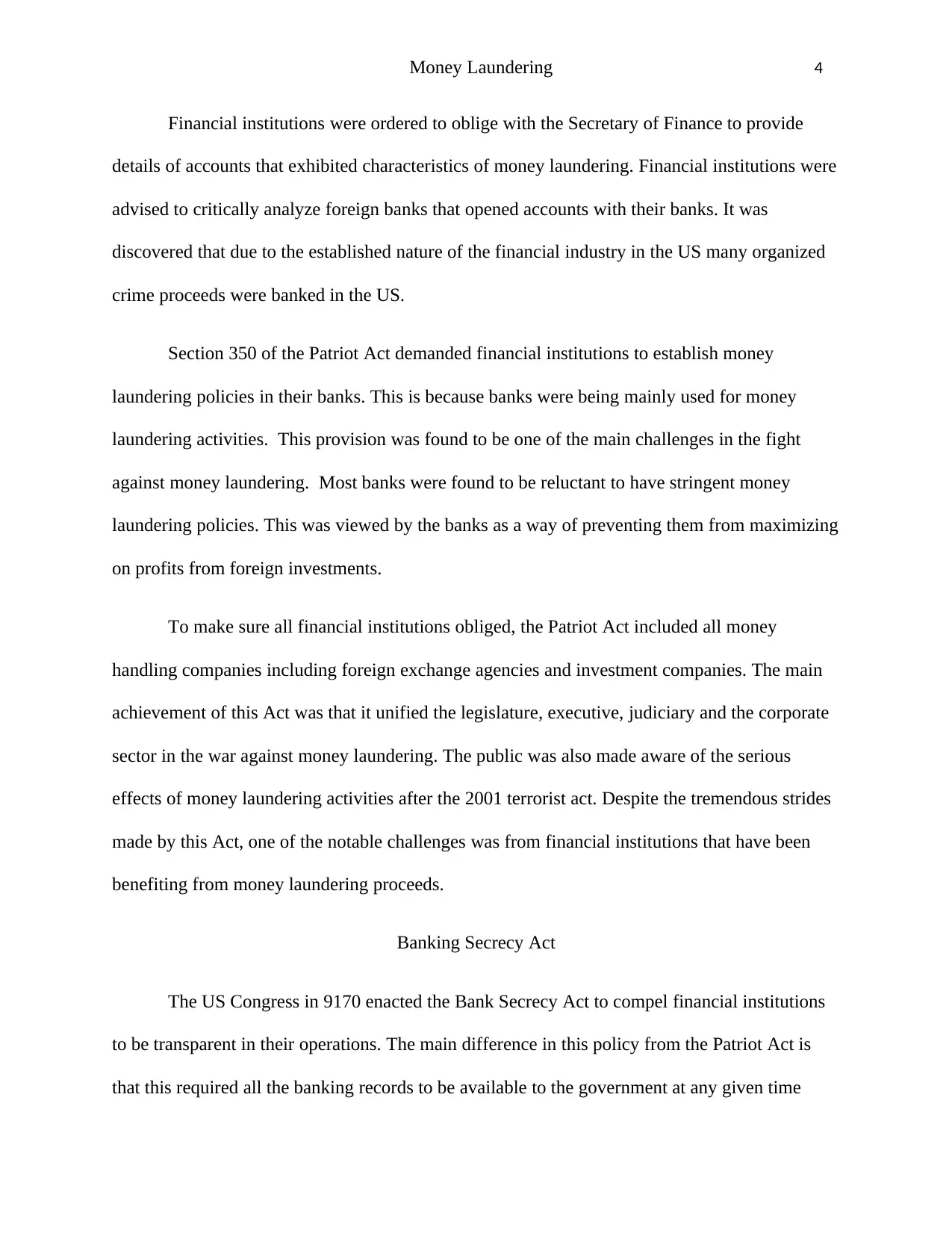
Money Laundering 4
Financial institutions were ordered to oblige with the Secretary of Finance to provide
details of accounts that exhibited characteristics of money laundering. Financial institutions were
advised to critically analyze foreign banks that opened accounts with their banks. It was
discovered that due to the established nature of the financial industry in the US many organized
crime proceeds were banked in the US.
Section 350 of the Patriot Act demanded financial institutions to establish money
laundering policies in their banks. This is because banks were being mainly used for money
laundering activities. This provision was found to be one of the main challenges in the fight
against money laundering. Most banks were found to be reluctant to have stringent money
laundering policies. This was viewed by the banks as a way of preventing them from maximizing
on profits from foreign investments.
To make sure all financial institutions obliged, the Patriot Act included all money
handling companies including foreign exchange agencies and investment companies. The main
achievement of this Act was that it unified the legislature, executive, judiciary and the corporate
sector in the war against money laundering. The public was also made aware of the serious
effects of money laundering activities after the 2001 terrorist act. Despite the tremendous strides
made by this Act, one of the notable challenges was from financial institutions that have been
benefiting from money laundering proceeds.
Banking Secrecy Act
The US Congress in 9170 enacted the Bank Secrecy Act to compel financial institutions
to be transparent in their operations. The main difference in this policy from the Patriot Act is
that this required all the banking records to be available to the government at any given time
Financial institutions were ordered to oblige with the Secretary of Finance to provide
details of accounts that exhibited characteristics of money laundering. Financial institutions were
advised to critically analyze foreign banks that opened accounts with their banks. It was
discovered that due to the established nature of the financial industry in the US many organized
crime proceeds were banked in the US.
Section 350 of the Patriot Act demanded financial institutions to establish money
laundering policies in their banks. This is because banks were being mainly used for money
laundering activities. This provision was found to be one of the main challenges in the fight
against money laundering. Most banks were found to be reluctant to have stringent money
laundering policies. This was viewed by the banks as a way of preventing them from maximizing
on profits from foreign investments.
To make sure all financial institutions obliged, the Patriot Act included all money
handling companies including foreign exchange agencies and investment companies. The main
achievement of this Act was that it unified the legislature, executive, judiciary and the corporate
sector in the war against money laundering. The public was also made aware of the serious
effects of money laundering activities after the 2001 terrorist act. Despite the tremendous strides
made by this Act, one of the notable challenges was from financial institutions that have been
benefiting from money laundering proceeds.
Banking Secrecy Act
The US Congress in 9170 enacted the Bank Secrecy Act to compel financial institutions
to be transparent in their operations. The main difference in this policy from the Patriot Act is
that this required all the banking records to be available to the government at any given time
Paraphrase This Document
Need a fresh take? Get an instant paraphrase of this document with our AI Paraphraser

Money Laundering 5
upon request. Congress believed that a proper audit of suspect accounts will only be possible if
the banks work together with legal authorities.
Most of the red-flagged accounts were found to have been consistent with concealing
crucial information from the authorities. The ultimate goal for enforcing the secrecy law was to
disrupt the activities of money laundering. Although this approach proved challenging, the
provisions were changed to include accounts that were suspect. Some of these challenges are the
ones this paper is addressing that have created many obstacles to the fight against money
laundering.
The advantage of the secrecy act was in identifying the source of the money being
laundered. It was believed that by knowing where the funds originated from will provide the
government with a pointer to arrest the money laundering criminals. This act provided the legal
structure to prevent illicit money from being integrated into the mainstream economy.
The Secretary of Treasury was charged with the main responsibility of implementing the
secrecy act. Bank records were found to be very important assets in the fight against money
laundering. The treasury secretary focused on bank records that looked suspicious. The main
challenge to this approach is that most banks were faced with the dilemma of keeping their
customers' financial details a secret and not providing their information to the government. This
made many organized crime units to shift their banking operations to financial safe heavens.
These countries did not comply with the secrecy act. Money banked in such countries always
found their way back to established economies like the US and UK to advance criminal
operations.
upon request. Congress believed that a proper audit of suspect accounts will only be possible if
the banks work together with legal authorities.
Most of the red-flagged accounts were found to have been consistent with concealing
crucial information from the authorities. The ultimate goal for enforcing the secrecy law was to
disrupt the activities of money laundering. Although this approach proved challenging, the
provisions were changed to include accounts that were suspect. Some of these challenges are the
ones this paper is addressing that have created many obstacles to the fight against money
laundering.
The advantage of the secrecy act was in identifying the source of the money being
laundered. It was believed that by knowing where the funds originated from will provide the
government with a pointer to arrest the money laundering criminals. This act provided the legal
structure to prevent illicit money from being integrated into the mainstream economy.
The Secretary of Treasury was charged with the main responsibility of implementing the
secrecy act. Bank records were found to be very important assets in the fight against money
laundering. The treasury secretary focused on bank records that looked suspicious. The main
challenge to this approach is that most banks were faced with the dilemma of keeping their
customers' financial details a secret and not providing their information to the government. This
made many organized crime units to shift their banking operations to financial safe heavens.
These countries did not comply with the secrecy act. Money banked in such countries always
found their way back to established economies like the US and UK to advance criminal
operations.
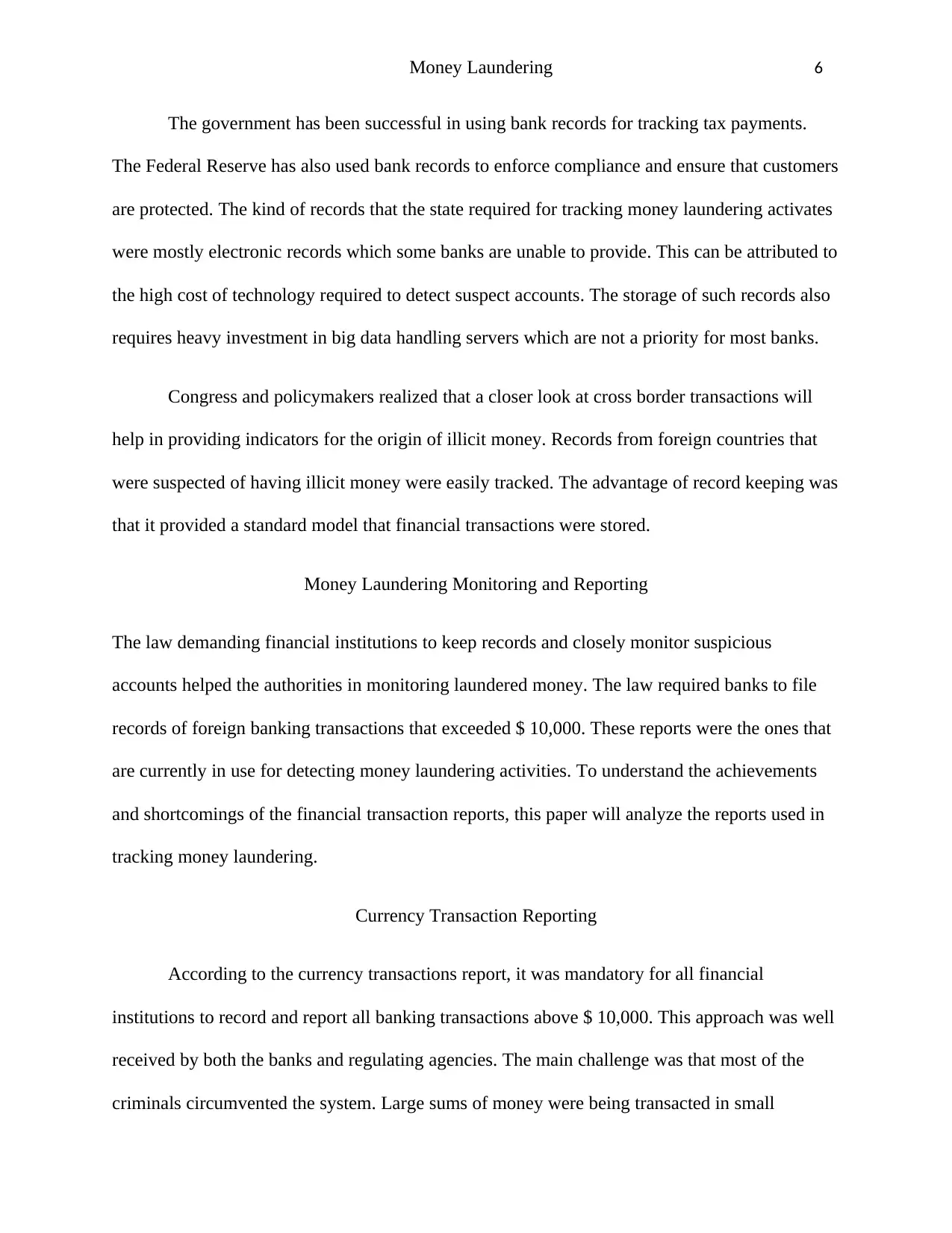
Money Laundering 6
The government has been successful in using bank records for tracking tax payments.
The Federal Reserve has also used bank records to enforce compliance and ensure that customers
are protected. The kind of records that the state required for tracking money laundering activates
were mostly electronic records which some banks are unable to provide. This can be attributed to
the high cost of technology required to detect suspect accounts. The storage of such records also
requires heavy investment in big data handling servers which are not a priority for most banks.
Congress and policymakers realized that a closer look at cross border transactions will
help in providing indicators for the origin of illicit money. Records from foreign countries that
were suspected of having illicit money were easily tracked. The advantage of record keeping was
that it provided a standard model that financial transactions were stored.
Money Laundering Monitoring and Reporting
The law demanding financial institutions to keep records and closely monitor suspicious
accounts helped the authorities in monitoring laundered money. The law required banks to file
records of foreign banking transactions that exceeded $ 10,000. These reports were the ones that
are currently in use for detecting money laundering activities. To understand the achievements
and shortcomings of the financial transaction reports, this paper will analyze the reports used in
tracking money laundering.
Currency Transaction Reporting
According to the currency transactions report, it was mandatory for all financial
institutions to record and report all banking transactions above $ 10,000. This approach was well
received by both the banks and regulating agencies. The main challenge was that most of the
criminals circumvented the system. Large sums of money were being transacted in small
The government has been successful in using bank records for tracking tax payments.
The Federal Reserve has also used bank records to enforce compliance and ensure that customers
are protected. The kind of records that the state required for tracking money laundering activates
were mostly electronic records which some banks are unable to provide. This can be attributed to
the high cost of technology required to detect suspect accounts. The storage of such records also
requires heavy investment in big data handling servers which are not a priority for most banks.
Congress and policymakers realized that a closer look at cross border transactions will
help in providing indicators for the origin of illicit money. Records from foreign countries that
were suspected of having illicit money were easily tracked. The advantage of record keeping was
that it provided a standard model that financial transactions were stored.
Money Laundering Monitoring and Reporting
The law demanding financial institutions to keep records and closely monitor suspicious
accounts helped the authorities in monitoring laundered money. The law required banks to file
records of foreign banking transactions that exceeded $ 10,000. These reports were the ones that
are currently in use for detecting money laundering activities. To understand the achievements
and shortcomings of the financial transaction reports, this paper will analyze the reports used in
tracking money laundering.
Currency Transaction Reporting
According to the currency transactions report, it was mandatory for all financial
institutions to record and report all banking transactions above $ 10,000. This approach was well
received by both the banks and regulating agencies. The main challenge was that most of the
criminals circumvented the system. Large sums of money were being transacted in small
⊘ This is a preview!⊘
Do you want full access?
Subscribe today to unlock all pages.

Trusted by 1+ million students worldwide
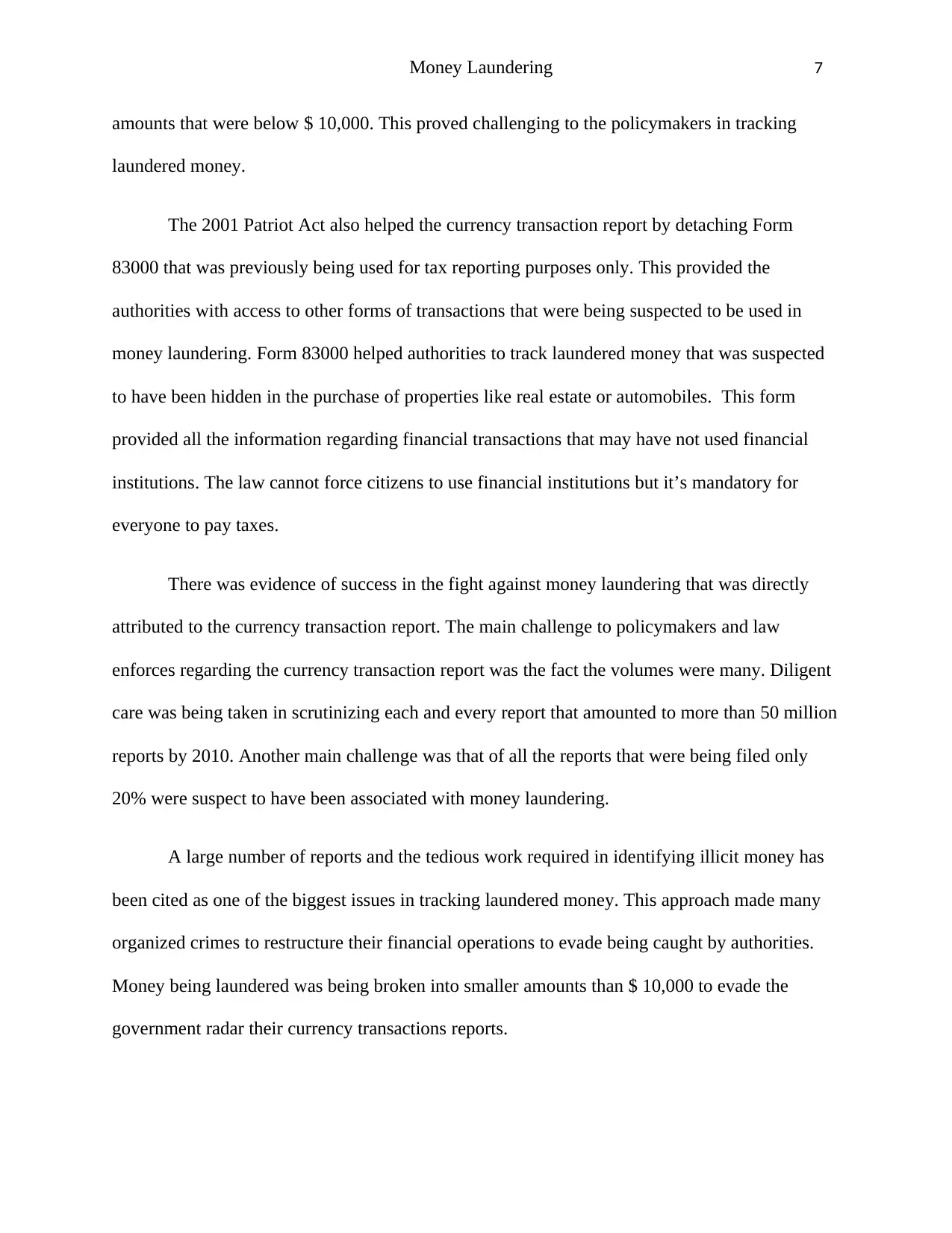
Money Laundering 7
amounts that were below $ 10,000. This proved challenging to the policymakers in tracking
laundered money.
The 2001 Patriot Act also helped the currency transaction report by detaching Form
83000 that was previously being used for tax reporting purposes only. This provided the
authorities with access to other forms of transactions that were being suspected to be used in
money laundering. Form 83000 helped authorities to track laundered money that was suspected
to have been hidden in the purchase of properties like real estate or automobiles. This form
provided all the information regarding financial transactions that may have not used financial
institutions. The law cannot force citizens to use financial institutions but it’s mandatory for
everyone to pay taxes.
There was evidence of success in the fight against money laundering that was directly
attributed to the currency transaction report. The main challenge to policymakers and law
enforces regarding the currency transaction report was the fact the volumes were many. Diligent
care was being taken in scrutinizing each and every report that amounted to more than 50 million
reports by 2010. Another main challenge was that of all the reports that were being filed only
20% were suspect to have been associated with money laundering.
A large number of reports and the tedious work required in identifying illicit money has
been cited as one of the biggest issues in tracking laundered money. This approach made many
organized crimes to restructure their financial operations to evade being caught by authorities.
Money being laundered was being broken into smaller amounts than $ 10,000 to evade the
government radar their currency transactions reports.
amounts that were below $ 10,000. This proved challenging to the policymakers in tracking
laundered money.
The 2001 Patriot Act also helped the currency transaction report by detaching Form
83000 that was previously being used for tax reporting purposes only. This provided the
authorities with access to other forms of transactions that were being suspected to be used in
money laundering. Form 83000 helped authorities to track laundered money that was suspected
to have been hidden in the purchase of properties like real estate or automobiles. This form
provided all the information regarding financial transactions that may have not used financial
institutions. The law cannot force citizens to use financial institutions but it’s mandatory for
everyone to pay taxes.
There was evidence of success in the fight against money laundering that was directly
attributed to the currency transaction report. The main challenge to policymakers and law
enforces regarding the currency transaction report was the fact the volumes were many. Diligent
care was being taken in scrutinizing each and every report that amounted to more than 50 million
reports by 2010. Another main challenge was that of all the reports that were being filed only
20% were suspect to have been associated with money laundering.
A large number of reports and the tedious work required in identifying illicit money has
been cited as one of the biggest issues in tracking laundered money. This approach made many
organized crimes to restructure their financial operations to evade being caught by authorities.
Money being laundered was being broken into smaller amounts than $ 10,000 to evade the
government radar their currency transactions reports.
Paraphrase This Document
Need a fresh take? Get an instant paraphrase of this document with our AI Paraphraser
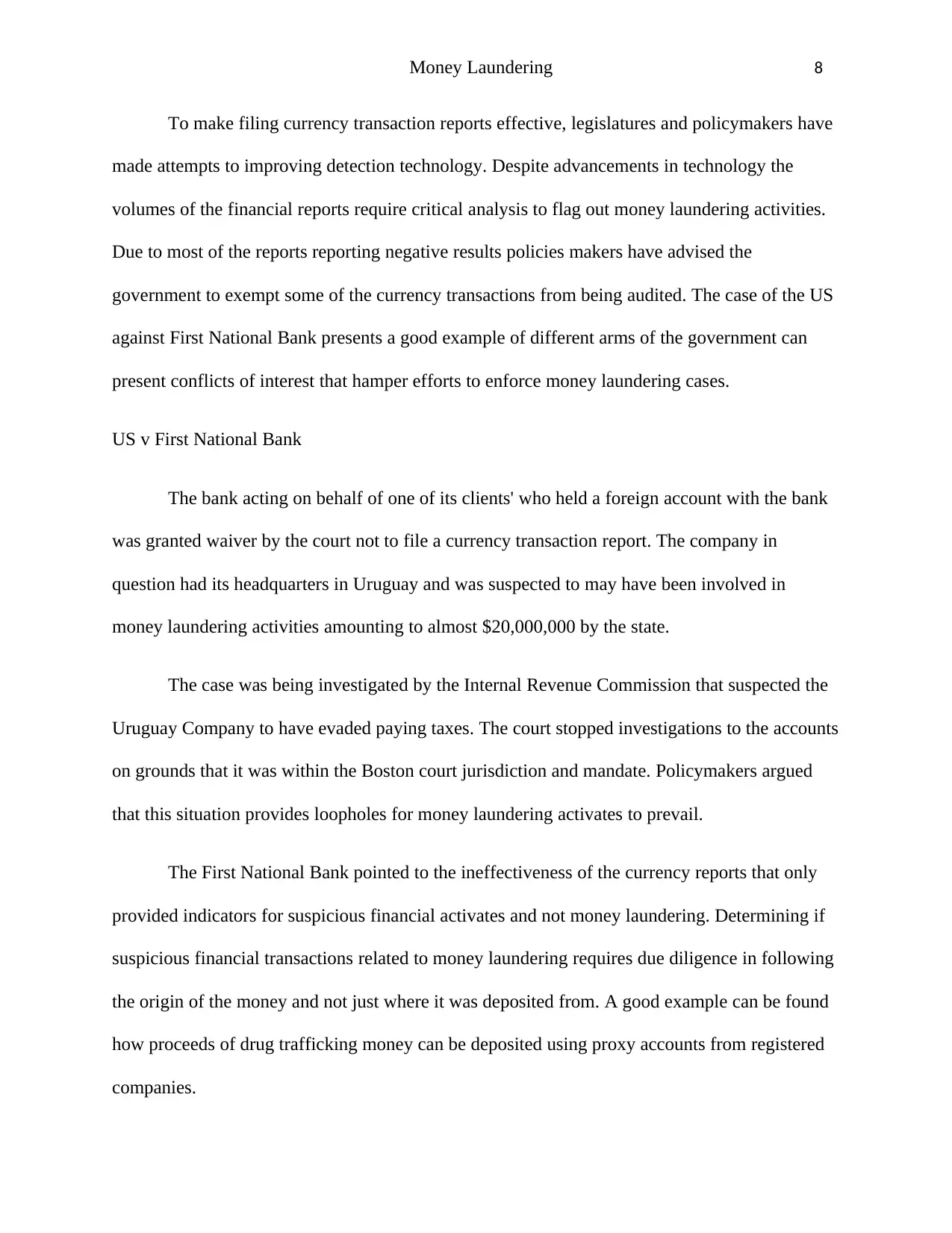
Money Laundering 8
To make filing currency transaction reports effective, legislatures and policymakers have
made attempts to improving detection technology. Despite advancements in technology the
volumes of the financial reports require critical analysis to flag out money laundering activities.
Due to most of the reports reporting negative results policies makers have advised the
government to exempt some of the currency transactions from being audited. The case of the US
against First National Bank presents a good example of different arms of the government can
present conflicts of interest that hamper efforts to enforce money laundering cases.
US v First National Bank
The bank acting on behalf of one of its clients' who held a foreign account with the bank
was granted waiver by the court not to file a currency transaction report. The company in
question had its headquarters in Uruguay and was suspected to may have been involved in
money laundering activities amounting to almost $20,000,000 by the state.
The case was being investigated by the Internal Revenue Commission that suspected the
Uruguay Company to have evaded paying taxes. The court stopped investigations to the accounts
on grounds that it was within the Boston court jurisdiction and mandate. Policymakers argued
that this situation provides loopholes for money laundering activates to prevail.
The First National Bank pointed to the ineffectiveness of the currency reports that only
provided indicators for suspicious financial activates and not money laundering. Determining if
suspicious financial transactions related to money laundering requires due diligence in following
the origin of the money and not just where it was deposited from. A good example can be found
how proceeds of drug trafficking money can be deposited using proxy accounts from registered
companies.
To make filing currency transaction reports effective, legislatures and policymakers have
made attempts to improving detection technology. Despite advancements in technology the
volumes of the financial reports require critical analysis to flag out money laundering activities.
Due to most of the reports reporting negative results policies makers have advised the
government to exempt some of the currency transactions from being audited. The case of the US
against First National Bank presents a good example of different arms of the government can
present conflicts of interest that hamper efforts to enforce money laundering cases.
US v First National Bank
The bank acting on behalf of one of its clients' who held a foreign account with the bank
was granted waiver by the court not to file a currency transaction report. The company in
question had its headquarters in Uruguay and was suspected to may have been involved in
money laundering activities amounting to almost $20,000,000 by the state.
The case was being investigated by the Internal Revenue Commission that suspected the
Uruguay Company to have evaded paying taxes. The court stopped investigations to the accounts
on grounds that it was within the Boston court jurisdiction and mandate. Policymakers argued
that this situation provides loopholes for money laundering activates to prevail.
The First National Bank pointed to the ineffectiveness of the currency reports that only
provided indicators for suspicious financial activates and not money laundering. Determining if
suspicious financial transactions related to money laundering requires due diligence in following
the origin of the money and not just where it was deposited from. A good example can be found
how proceeds of drug trafficking money can be deposited using proxy accounts from registered
companies.
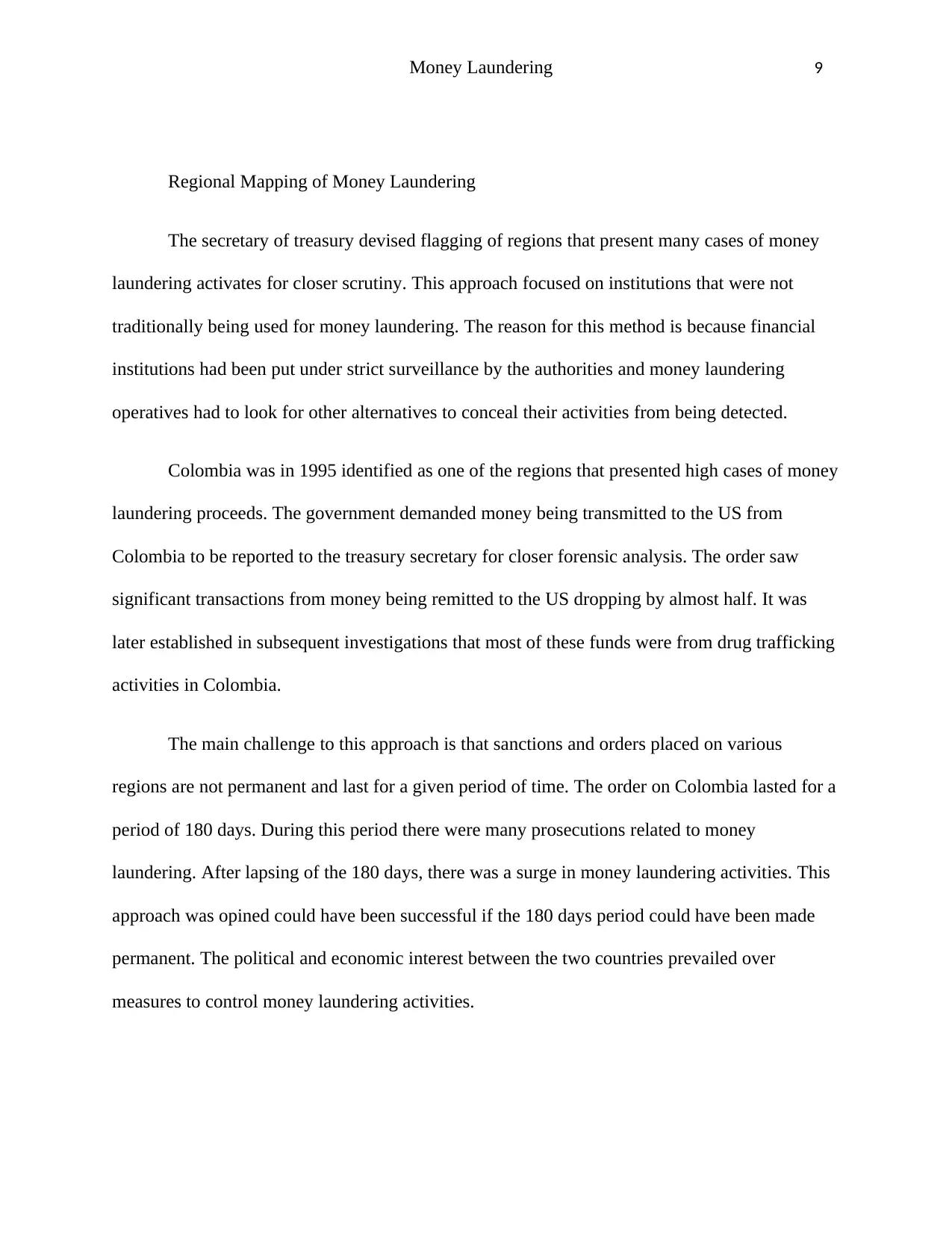
Money Laundering 9
Regional Mapping of Money Laundering
The secretary of treasury devised flagging of regions that present many cases of money
laundering activates for closer scrutiny. This approach focused on institutions that were not
traditionally being used for money laundering. The reason for this method is because financial
institutions had been put under strict surveillance by the authorities and money laundering
operatives had to look for other alternatives to conceal their activities from being detected.
Colombia was in 1995 identified as one of the regions that presented high cases of money
laundering proceeds. The government demanded money being transmitted to the US from
Colombia to be reported to the treasury secretary for closer forensic analysis. The order saw
significant transactions from money being remitted to the US dropping by almost half. It was
later established in subsequent investigations that most of these funds were from drug trafficking
activities in Colombia.
The main challenge to this approach is that sanctions and orders placed on various
regions are not permanent and last for a given period of time. The order on Colombia lasted for a
period of 180 days. During this period there were many prosecutions related to money
laundering. After lapsing of the 180 days, there was a surge in money laundering activities. This
approach was opined could have been successful if the 180 days period could have been made
permanent. The political and economic interest between the two countries prevailed over
measures to control money laundering activities.
Regional Mapping of Money Laundering
The secretary of treasury devised flagging of regions that present many cases of money
laundering activates for closer scrutiny. This approach focused on institutions that were not
traditionally being used for money laundering. The reason for this method is because financial
institutions had been put under strict surveillance by the authorities and money laundering
operatives had to look for other alternatives to conceal their activities from being detected.
Colombia was in 1995 identified as one of the regions that presented high cases of money
laundering proceeds. The government demanded money being transmitted to the US from
Colombia to be reported to the treasury secretary for closer forensic analysis. The order saw
significant transactions from money being remitted to the US dropping by almost half. It was
later established in subsequent investigations that most of these funds were from drug trafficking
activities in Colombia.
The main challenge to this approach is that sanctions and orders placed on various
regions are not permanent and last for a given period of time. The order on Colombia lasted for a
period of 180 days. During this period there were many prosecutions related to money
laundering. After lapsing of the 180 days, there was a surge in money laundering activities. This
approach was opined could have been successful if the 180 days period could have been made
permanent. The political and economic interest between the two countries prevailed over
measures to control money laundering activities.
⊘ This is a preview!⊘
Do you want full access?
Subscribe today to unlock all pages.

Trusted by 1+ million students worldwide
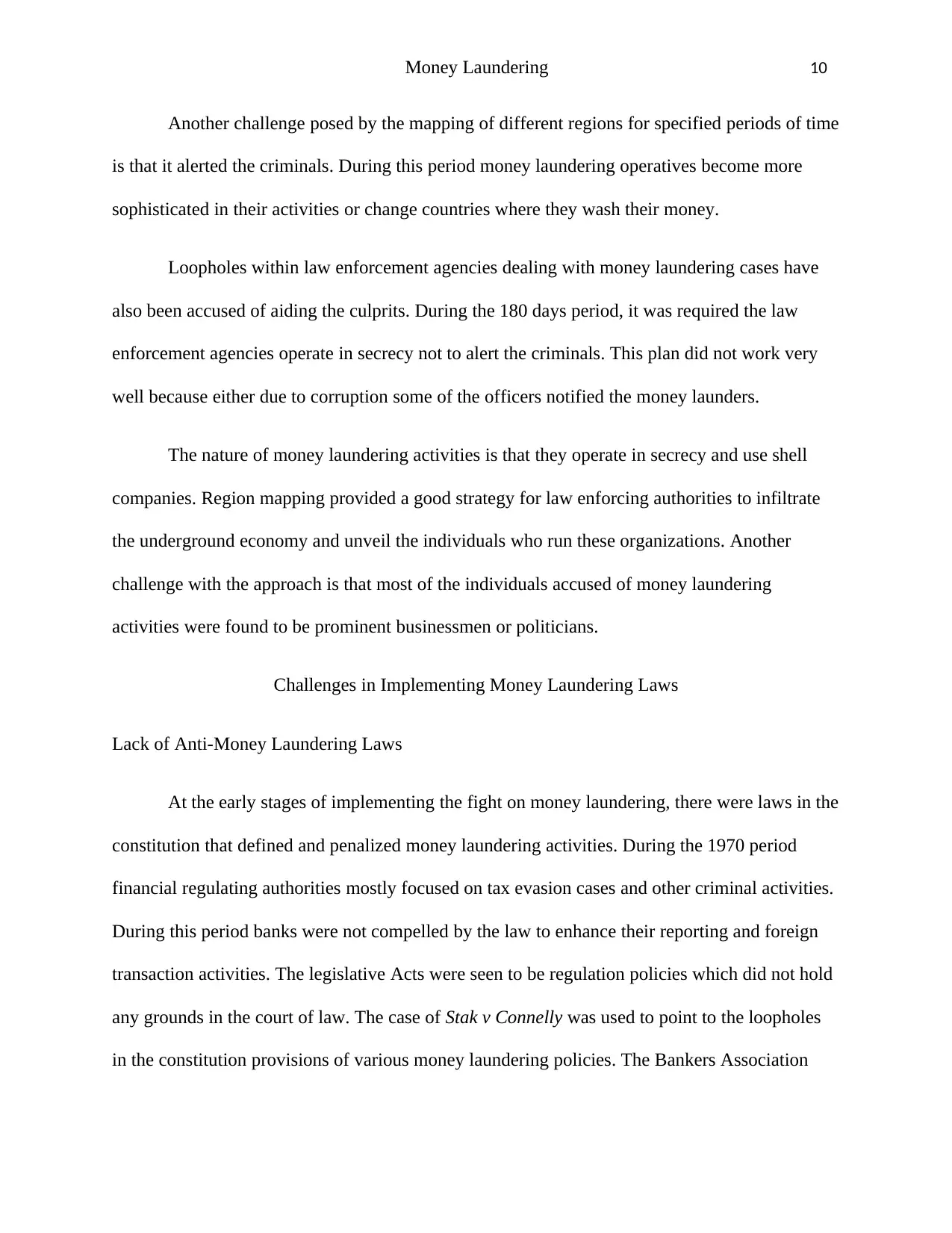
Money Laundering 10
Another challenge posed by the mapping of different regions for specified periods of time
is that it alerted the criminals. During this period money laundering operatives become more
sophisticated in their activities or change countries where they wash their money.
Loopholes within law enforcement agencies dealing with money laundering cases have
also been accused of aiding the culprits. During the 180 days period, it was required the law
enforcement agencies operate in secrecy not to alert the criminals. This plan did not work very
well because either due to corruption some of the officers notified the money launders.
The nature of money laundering activities is that they operate in secrecy and use shell
companies. Region mapping provided a good strategy for law enforcing authorities to infiltrate
the underground economy and unveil the individuals who run these organizations. Another
challenge with the approach is that most of the individuals accused of money laundering
activities were found to be prominent businessmen or politicians.
Challenges in Implementing Money Laundering Laws
Lack of Anti-Money Laundering Laws
At the early stages of implementing the fight on money laundering, there were laws in the
constitution that defined and penalized money laundering activities. During the 1970 period
financial regulating authorities mostly focused on tax evasion cases and other criminal activities.
During this period banks were not compelled by the law to enhance their reporting and foreign
transaction activities. The legislative Acts were seen to be regulation policies which did not hold
any grounds in the court of law. The case of Stak v Connelly was used to point to the loopholes
in the constitution provisions of various money laundering policies. The Bankers Association
Another challenge posed by the mapping of different regions for specified periods of time
is that it alerted the criminals. During this period money laundering operatives become more
sophisticated in their activities or change countries where they wash their money.
Loopholes within law enforcement agencies dealing with money laundering cases have
also been accused of aiding the culprits. During the 180 days period, it was required the law
enforcement agencies operate in secrecy not to alert the criminals. This plan did not work very
well because either due to corruption some of the officers notified the money launders.
The nature of money laundering activities is that they operate in secrecy and use shell
companies. Region mapping provided a good strategy for law enforcing authorities to infiltrate
the underground economy and unveil the individuals who run these organizations. Another
challenge with the approach is that most of the individuals accused of money laundering
activities were found to be prominent businessmen or politicians.
Challenges in Implementing Money Laundering Laws
Lack of Anti-Money Laundering Laws
At the early stages of implementing the fight on money laundering, there were laws in the
constitution that defined and penalized money laundering activities. During the 1970 period
financial regulating authorities mostly focused on tax evasion cases and other criminal activities.
During this period banks were not compelled by the law to enhance their reporting and foreign
transaction activities. The legislative Acts were seen to be regulation policies which did not hold
any grounds in the court of law. The case of Stak v Connelly was used to point to the loopholes
in the constitution provisions of various money laundering policies. The Bankers Association
Paraphrase This Document
Need a fresh take? Get an instant paraphrase of this document with our AI Paraphraser
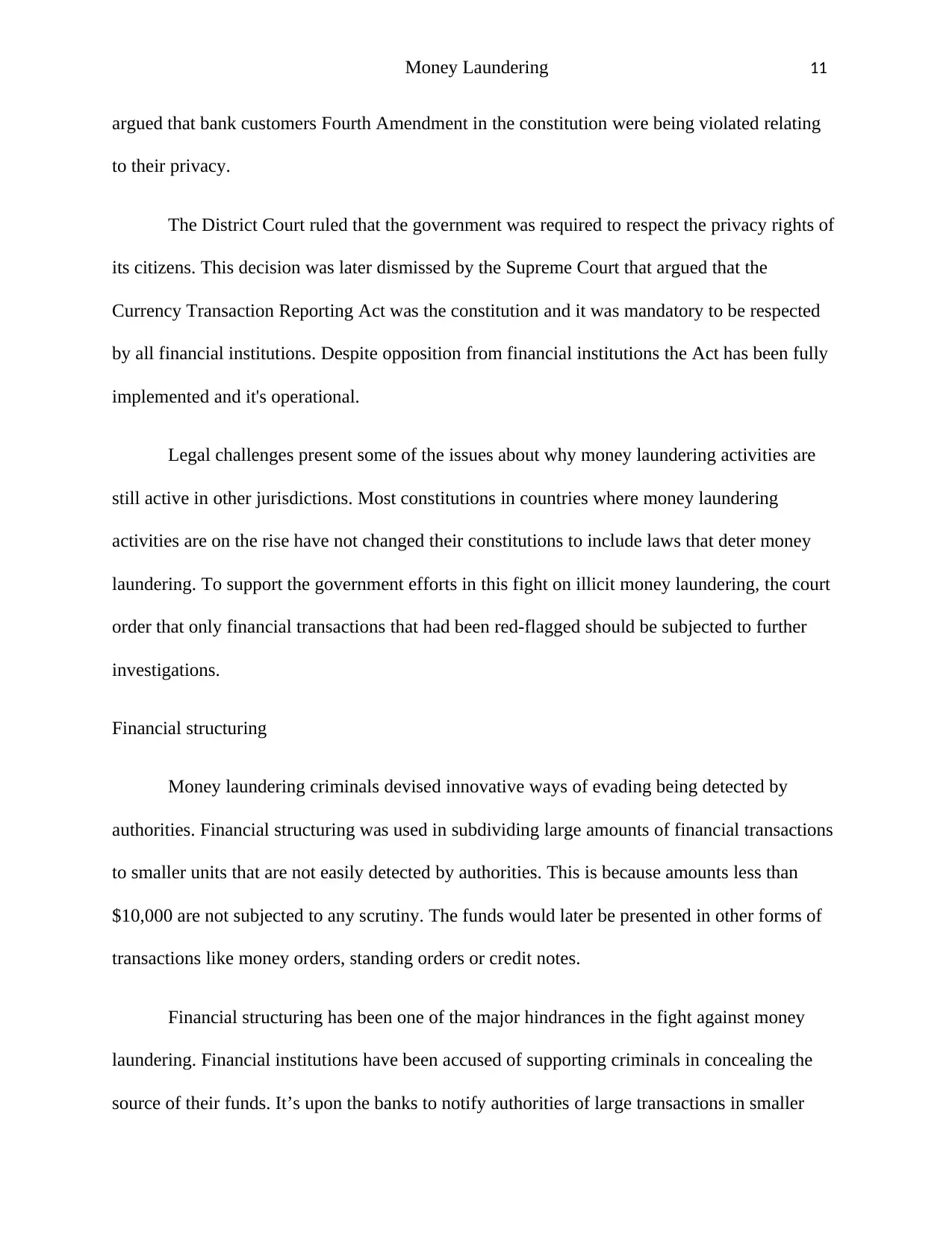
Money Laundering 11
argued that bank customers Fourth Amendment in the constitution were being violated relating
to their privacy.
The District Court ruled that the government was required to respect the privacy rights of
its citizens. This decision was later dismissed by the Supreme Court that argued that the
Currency Transaction Reporting Act was the constitution and it was mandatory to be respected
by all financial institutions. Despite opposition from financial institutions the Act has been fully
implemented and it's operational.
Legal challenges present some of the issues about why money laundering activities are
still active in other jurisdictions. Most constitutions in countries where money laundering
activities are on the rise have not changed their constitutions to include laws that deter money
laundering. To support the government efforts in this fight on illicit money laundering, the court
order that only financial transactions that had been red-flagged should be subjected to further
investigations.
Financial structuring
Money laundering criminals devised innovative ways of evading being detected by
authorities. Financial structuring was used in subdividing large amounts of financial transactions
to smaller units that are not easily detected by authorities. This is because amounts less than
$10,000 are not subjected to any scrutiny. The funds would later be presented in other forms of
transactions like money orders, standing orders or credit notes.
Financial structuring has been one of the major hindrances in the fight against money
laundering. Financial institutions have been accused of supporting criminals in concealing the
source of their funds. It’s upon the banks to notify authorities of large transactions in smaller
argued that bank customers Fourth Amendment in the constitution were being violated relating
to their privacy.
The District Court ruled that the government was required to respect the privacy rights of
its citizens. This decision was later dismissed by the Supreme Court that argued that the
Currency Transaction Reporting Act was the constitution and it was mandatory to be respected
by all financial institutions. Despite opposition from financial institutions the Act has been fully
implemented and it's operational.
Legal challenges present some of the issues about why money laundering activities are
still active in other jurisdictions. Most constitutions in countries where money laundering
activities are on the rise have not changed their constitutions to include laws that deter money
laundering. To support the government efforts in this fight on illicit money laundering, the court
order that only financial transactions that had been red-flagged should be subjected to further
investigations.
Financial structuring
Money laundering criminals devised innovative ways of evading being detected by
authorities. Financial structuring was used in subdividing large amounts of financial transactions
to smaller units that are not easily detected by authorities. This is because amounts less than
$10,000 are not subjected to any scrutiny. The funds would later be presented in other forms of
transactions like money orders, standing orders or credit notes.
Financial structuring has been one of the major hindrances in the fight against money
laundering. Financial institutions have been accused of supporting criminals in concealing the
source of their funds. It’s upon the banks to notify authorities of large transactions in smaller
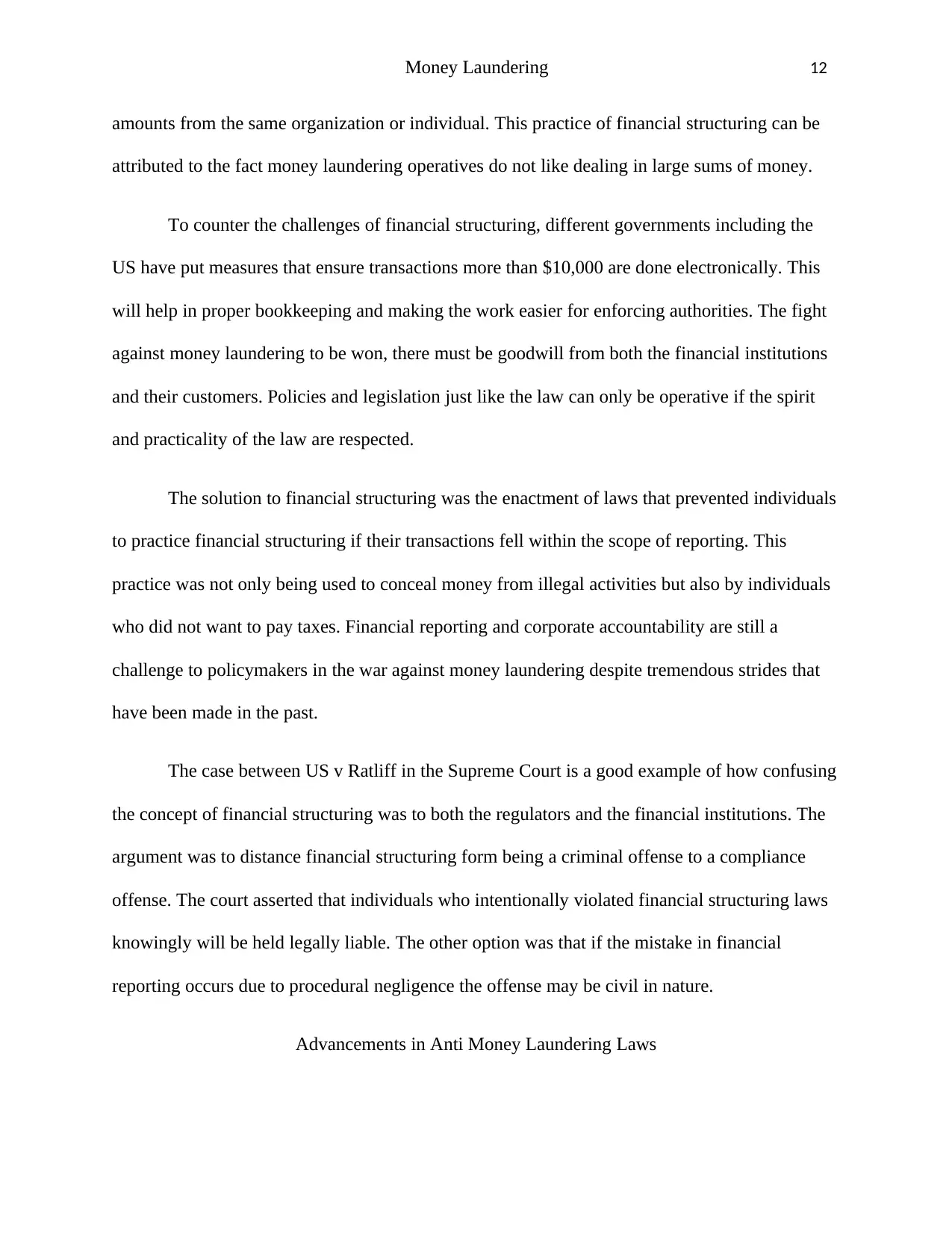
Money Laundering 12
amounts from the same organization or individual. This practice of financial structuring can be
attributed to the fact money laundering operatives do not like dealing in large sums of money.
To counter the challenges of financial structuring, different governments including the
US have put measures that ensure transactions more than $10,000 are done electronically. This
will help in proper bookkeeping and making the work easier for enforcing authorities. The fight
against money laundering to be won, there must be goodwill from both the financial institutions
and their customers. Policies and legislation just like the law can only be operative if the spirit
and practicality of the law are respected.
The solution to financial structuring was the enactment of laws that prevented individuals
to practice financial structuring if their transactions fell within the scope of reporting. This
practice was not only being used to conceal money from illegal activities but also by individuals
who did not want to pay taxes. Financial reporting and corporate accountability are still a
challenge to policymakers in the war against money laundering despite tremendous strides that
have been made in the past.
The case between US v Ratliff in the Supreme Court is a good example of how confusing
the concept of financial structuring was to both the regulators and the financial institutions. The
argument was to distance financial structuring form being a criminal offense to a compliance
offense. The court asserted that individuals who intentionally violated financial structuring laws
knowingly will be held legally liable. The other option was that if the mistake in financial
reporting occurs due to procedural negligence the offense may be civil in nature.
Advancements in Anti Money Laundering Laws
amounts from the same organization or individual. This practice of financial structuring can be
attributed to the fact money laundering operatives do not like dealing in large sums of money.
To counter the challenges of financial structuring, different governments including the
US have put measures that ensure transactions more than $10,000 are done electronically. This
will help in proper bookkeeping and making the work easier for enforcing authorities. The fight
against money laundering to be won, there must be goodwill from both the financial institutions
and their customers. Policies and legislation just like the law can only be operative if the spirit
and practicality of the law are respected.
The solution to financial structuring was the enactment of laws that prevented individuals
to practice financial structuring if their transactions fell within the scope of reporting. This
practice was not only being used to conceal money from illegal activities but also by individuals
who did not want to pay taxes. Financial reporting and corporate accountability are still a
challenge to policymakers in the war against money laundering despite tremendous strides that
have been made in the past.
The case between US v Ratliff in the Supreme Court is a good example of how confusing
the concept of financial structuring was to both the regulators and the financial institutions. The
argument was to distance financial structuring form being a criminal offense to a compliance
offense. The court asserted that individuals who intentionally violated financial structuring laws
knowingly will be held legally liable. The other option was that if the mistake in financial
reporting occurs due to procedural negligence the offense may be civil in nature.
Advancements in Anti Money Laundering Laws
⊘ This is a preview!⊘
Do you want full access?
Subscribe today to unlock all pages.

Trusted by 1+ million students worldwide
1 out of 19
Related Documents
Your All-in-One AI-Powered Toolkit for Academic Success.
+13062052269
info@desklib.com
Available 24*7 on WhatsApp / Email
![[object Object]](/_next/static/media/star-bottom.7253800d.svg)
Unlock your academic potential
Copyright © 2020–2025 A2Z Services. All Rights Reserved. Developed and managed by ZUCOL.





